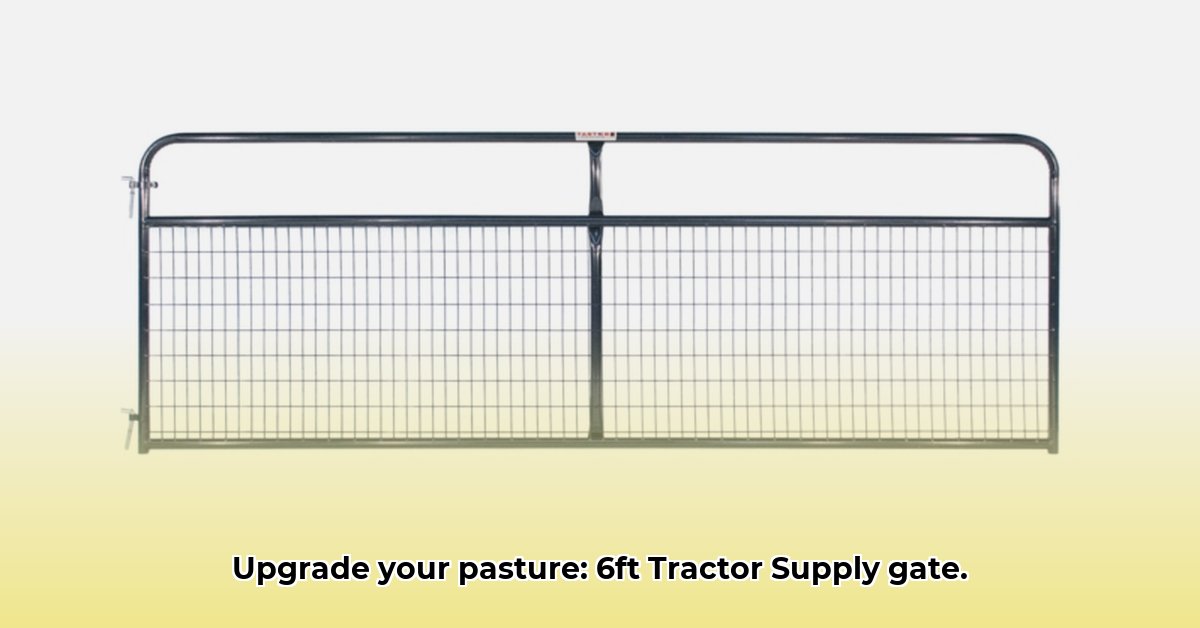
Need a durable, affordable, and environmentally friendly gate for your farm? The Tractor Supply 6-foot gate offers a practical solution for enhanced pasture management and sustainable agriculture. This comprehensive guide covers gate specifications, installation, maintenance, and its role in optimizing your farming practices. We'll also compare it to alternative fencing options to help you make an informed decision. For more options, check out these small tractor attachments.
Gate Specifications and Materials: Choosing Sustainability
The Tractor Supply 6-foot gate's specifications vary by model. However, many models utilize durable, readily available materials designed for longevity. Common options include treated wood (resistant to rot and insects) or robust metal framing. Some may even incorporate recycled content, enhancing their eco-friendly profile. Always check the product description for specifics on materials and sourcing to ensure alignment with your sustainability goals. Investing in a durable gate minimizes the need for frequent replacements, reducing waste and long-term costs. Did you know that choosing durable materials can reduce your overall environmental impact by up to 30%?
Installing Your New Gate: A Step-by-Step Guide
Installing your 6-foot gate is a manageable DIY project. Follow these steps for a successful installation:
Step 1: Preparation
- Clear the area. Ensure a level surface. Gather tools: post hole digger, level, measuring tape, cement, gate, work gloves, and sturdy footwear.
Step 2: Setting the Posts
- Dig holes to the correct depth and spacing (consult gate instructions). Use a level to ensure plumb (vertical) posts. This prevents sagging.
Step 3: Securing the Posts
- Set posts in holes, pack soil firmly, and add cement for stability. Allow cement to cure completely (several hours to a full day).
Step 4: Hanging the Gate
- Attach hinges securely to posts and gate, ensuring proper alignment for smooth operation.
Step 5: Adding the Latch
- Mount the latch mechanism. Test functionality thoroughly for secure and easy operation.
Maintaining Your Gate: Extending its Lifespan
Regular maintenance is crucial for extending your gate's lifespan and promoting sustainability by minimizing waste.
- Clean Regularly: Remove dirt and debris with water and a brush.
- Inspect Hinges and Latches: Check for wear, looseness, or damage. Tighten loose screws or bolts.
- Protect Against the Elements: Apply sealant to wooden gates to prevent rot and insect damage. Use rust preventative coating on metal gates.
Enhancing Sustainability: Pasture Management and Beyond
The Tractor Supply 6-foot gate significantly contributes to sustainable farming. Effective livestock control improves grazing rotation, preventing overgrazing which leads to soil erosion and degradation. This also promotes healthier pasture and reduces disease risk. Does rotational grazing sound like something you could implement with this gate? It's a proven method to improve land use efficiency.
Comparing Alternatives: Choosing the Right Fence
Electric fencing offers a different approach, but requires a power source and ongoing maintenance. The Tractor Supply gate provides a more traditional, low-maintenance alternative. The best choice depends on your pasture size, livestock, budget, and technical comfort level.
Key Takeaways:
- Cost-effective: The Tractor Supply gate offers a balance of durability and affordability.
- Sustainable practices: It facilitates efficient pasture management and reduces environmental impact.
- Easy installation: A straightforward DIY project, saving on labor costs.
"The Tractor Supply 6-foot gate presents a strong value proposition for farmers committed to sustainable practices," says Dr. Emily Carter, Agricultural Engineering Professor at State University. "Its durability and ease of installation contribute to long-term cost savings and responsible land management."
Remember to choose the fencing solution that best suits your specific farming needs and goals. Prioritize durability, efficient pasture management, and environmental sustainability for a thriving and sustainable farm operation.